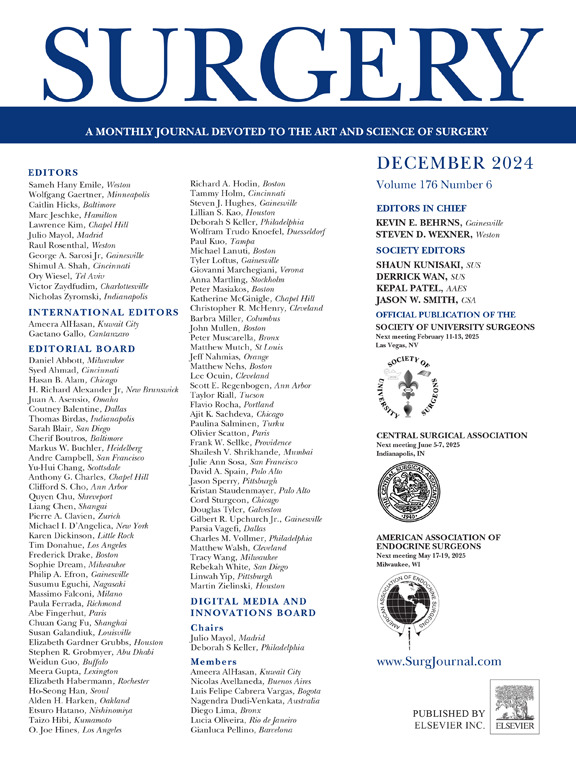Contemporary epidemiologic overview of adult liver trauma management across the United States: Analysis of the American College of Surgeons Trauma Quality Improvement Program database
IF 3.2
2区 医学
Q1 SURGERY
引用次数: 0
Abstract
Introduction
Multiple definitive and temporizing management techniques have been devised for liver trauma, and we have shifted toward nonoperative management as endovascular capabilities have evolved. Despite management guidelines, no large-scale data on implementation exist. This study characterizes current nationwide liver trauma management.
Methods
This was an analysis of 2017–2020 American College of Surgeons Trauma Quality Improvement Program. Adult patients with liver trauma were included, with the exclusion of those with severe extra-abdominal injuries (Abbreviated Injury Scale >3). Nonoperative management was defined as no exploratory laparotomy (ex-lap) within 6 hours. Primary outcomes were management strategies employed and failure of nonoperative management (ex-lap after 6 hours), stratified by injury mechanism, American Association for the Surgery of Trauma liver injury grade, and American College of Surgeons trauma center verification level. Secondary outcomes were mortality, survivor-only length of stay, and in-hospital complications. Interfacility transfer patients were subanalyzed.
Results
A total of 96,652 patients with liver trauma were identified, of which 60,199 were included [24% penetrating; 74% blunt]. In total, 60% grade I/II injuries, 21% grade III, 14% grade IV, 5% grade V, and 0.2% grade VI. Mean age 39 ± 17 years, 65% male, 58% White, ISS was 17[12–24], liver-AIS 2[2–4], and lowest systolic blood pressure within 1-hour was 84 ± 31 mm Hg. Mortality was 5%, hospital length of stay was 6 [2–13] days, and intensive care unit length of stay 3 [2–6] days. Both blunt and penetrating liver injuries of all severities were more likely to undergo operative management at higher American College of Surgeons trauma center verification levels. Of 13,672 patients who were transferred, 92% underwent nonoperative management, 1.3% angioembolization, and only 3.4% failed nonoperative management.
Conclusion
Liver trauma remains a major public health burden with mortality approaching 66% among severely injured patients, and current management shows significant nationwide variability. Blunt liver trauma is primarily being managed nonoperatively, and angioembolization is assuming a growing role. Very few patients who were transferred to greater levels of care required operative intervention, having implications for resource allocation.

美国成人肝损伤管理的当代流行病学综述:美国外科医师学会创伤质量改进计划数据库分析
针对肝外伤,我们已经设计了多种明确和暂时的治疗技术,随着血管内功能的发展,我们已经转向非手术治疗。尽管有管理准则,但没有关于执行情况的大规模数据。本研究描述了目前全国范围内肝外伤的管理。方法对2017-2020年美国外科医师学会创伤质量改善项目进行分析。纳入成人肝损伤患者,排除腹部外严重损伤患者(简易损伤量表>;3)。非手术治疗定义为6小时内未开腹探查。主要结局是采用的治疗策略和非手术治疗失败(6小时后开腹),根据损伤机制、美国创伤外科协会肝损伤分级和美国外科医师学会创伤中心验证水平进行分层。次要结局是死亡率、仅存活者住院时间和院内并发症。对医院间转院患者进行亚组分析。结果共发现肝外伤患者96652例,其中60199例纳入,穿透率24%;74%钝]。总的来说,60%为I/II级损伤,21%为III级损伤,14%为IV级损伤,5%为V级损伤,0.2%为VI级损伤。平均年龄39±17岁,65%为男性,58%为白人,ISS为17[12-24],肝脏- ais为2[2 - 4],1小时内最低收缩压为84±31 mm Hg。死亡率为5%,住院时间为6[2 - 13]天,重症监护病房住院时间为3[2 - 6]天。所有严重程度的钝性和穿透性肝损伤在美国外科医师学会创伤中心认证水平较高时更有可能接受手术治疗。在转入的13672例患者中,92%接受了非手术治疗,1.3%接受了血管栓塞治疗,只有3.4%的患者非手术治疗失败。结论肝损伤仍然是一个主要的公共卫生负担,在严重损伤患者中死亡率接近66%,目前的管理在全国范围内存在显著差异。钝性肝损伤主要是非手术治疗,血管栓塞正在发挥越来越大的作用。很少有患者转移到更高水平的护理需要手术干预,这对资源分配有影响。
本文章由计算机程序翻译,如有差异,请以英文原文为准。
求助全文
约1分钟内获得全文
求助全文
来源期刊

Surgery
医学-外科
CiteScore
5.40
自引率
5.30%
发文量
687
审稿时长
64 days
期刊介绍:
For 66 years, Surgery has published practical, authoritative information about procedures, clinical advances, and major trends shaping general surgery. Each issue features original scientific contributions and clinical reports. Peer-reviewed articles cover topics in oncology, trauma, gastrointestinal, vascular, and transplantation surgery. The journal also publishes papers from the meetings of its sponsoring societies, the Society of University Surgeons, the Central Surgical Association, and the American Association of Endocrine Surgeons.
 求助内容:
求助内容: 应助结果提醒方式:
应助结果提醒方式:


